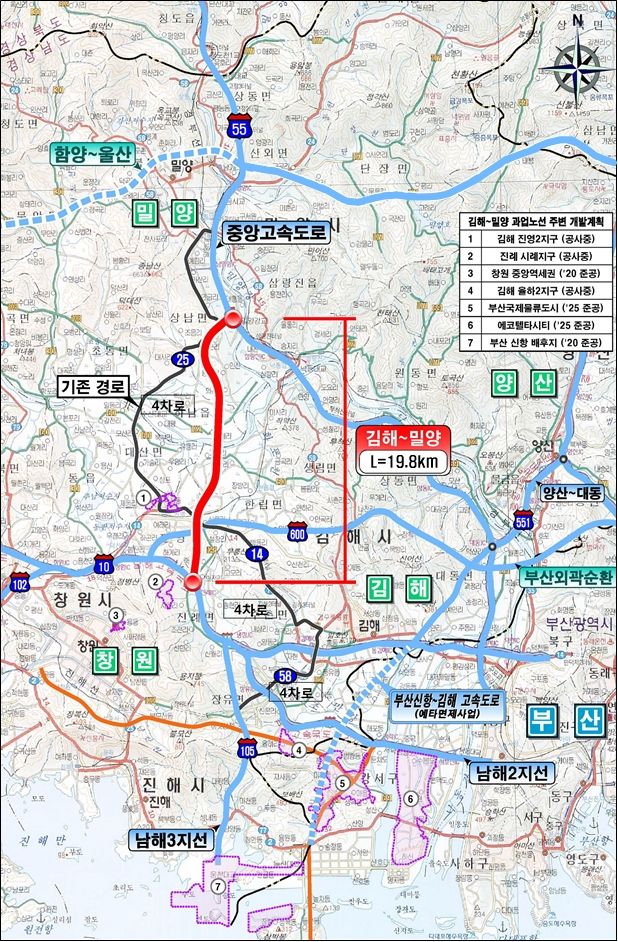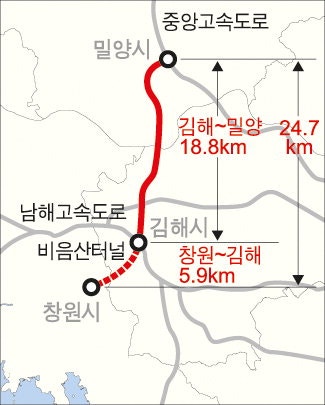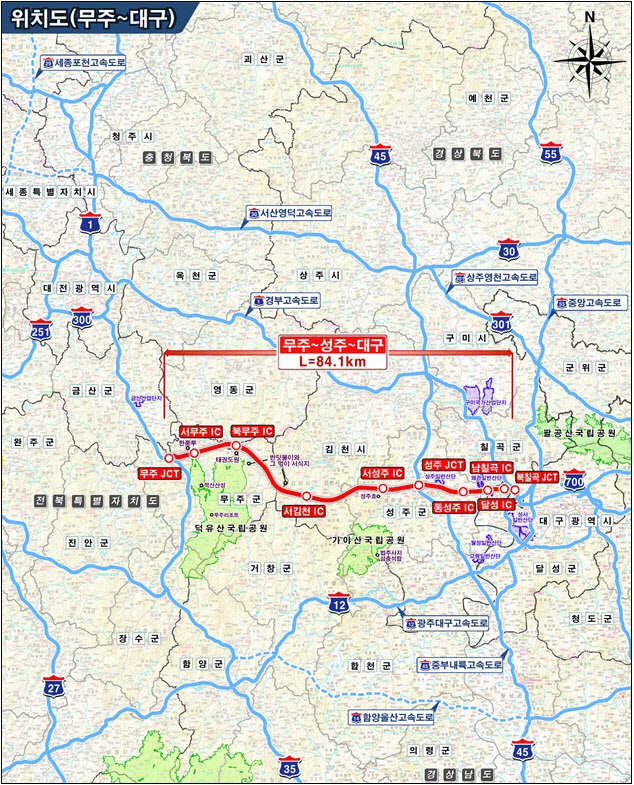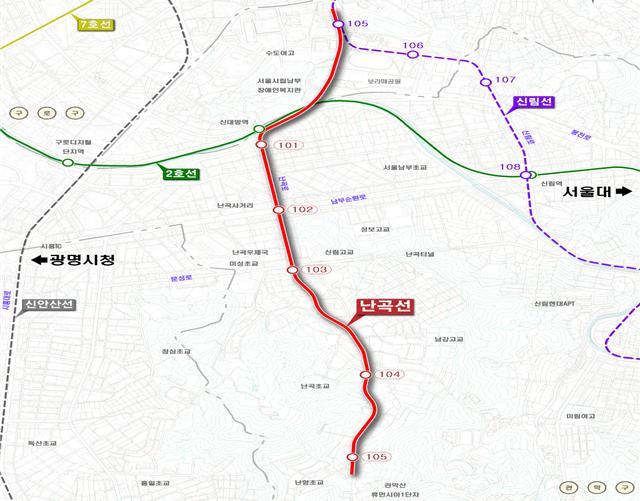Table of Contents
- Gimhae-Miryang Expressway Construction: A New Axis of the Southeastern Inland Transportation Network
- Honam Expressway Branch (Seodaejeon-Hwaideok) Expansion Project Also Passed Preliminary Feasibility Study
- Nine Projects Selected for Preliminary Feasibility Study
- Conclusion – The Significance of the Gimhae-Miryang Expressway as a New Backbone of Inland Transportation
- Frequently Asked Questions (FAQ)
Gimhae-Miryang Expressway Construction: A New Axis of the Southeastern Inland Transportation Network

On the 31st, Gyeongnam Miryang announced that the construction project of the Gimhae-Miryang Expressway has passed the preliminary feasibility study of the Korea Development Institute (KDI). This approval marks an important milestone that allows for the formal progression of subsequent procedures such as basic plan establishment and detailed design.
The construction of this expressway is evaluated as a very important infrastructure project for expanding the inland transportation network of the southeastern region. The Gimhae-Miryang Expressway will connect from Jinrae-myeon in Gimhae City to Sangnam-myeon in Miryang City, with a total length of 19.8 km and designed to be a four-lane road.
About 1.4965 trillion won will be invested in the project, and two interchanges (IC) and three junctions (JCT) are planned to be installed on this road. The establishment of this transportation infrastructure is expected to have a positive impact on the revitalization of the local economy.
This route will expand the coastal transportation axis centered around Busan, Ulsan, and Changwon inland. This will effectively connect major industrial hubs such as Busan New Port, Gadukdo New Airport, Gimhae Airport, and the Miryang Nano-Convergence National Industrial Complex. This connectivity is expected to enhance logistics efficiency in the southeastern industrial belt and promote balanced regional development.
Particularly, with the improved accessibility of Gadukdo New Airport, it is expected to contribute to strengthening the logistics competitiveness of the industrial complexes in Daegu and Gyeongnam. However, unfortunately, the section connected to Changwon through the Bi-eum Mountain Tunnel was not included in this discussion. Further discussions in the future are awaited.

The recent passing of the preliminary feasibility study is considered the result of cooperation between the two cities of Miryang and Gimhae and the active participation of local politics and the industrial community. The two local governments jointly adopted and delivered a resolution to urge the early commencement of the Gimhae-Miryang Expressway preliminary feasibility study in August, maintaining a continuous cooperation system for the promotion of the project. These efforts have borne fruit.
Honam Expressway Branch (Seodaejeon-Hwaideok) Expansion Project Also Passed Preliminary Feasibility Study

At the 10th Financial Project Evaluation Committee, the Gimhae-Miryang Expressway construction and the Honam Expressway branch (Seodaejeon-Hwaideok) expansion project passed their preliminary feasibility studies.
The Honam Expressway branch expansion project is a plan to widen the 18.6 km section from Wonnae-dong (Seodaejeon JCT) in Yuseong-gu, Daejeon to Jeonmin-dong (Hwaideok JCT) from four lanes to six lanes. The total cost of this project is about 352.2 billion won, and it is expected to contribute to solving the traffic increase and congestion issues during commuting in the Sejong-Daejeon area.
The Ministry of Strategy and Finance mentioned that the progress of these two expressway projects will greatly help reduce traffic congestion and enhance logistics competitiveness. These projects are also expected to positively impact the revitalization of the local economy.
Nine Projects Selected for Preliminary Feasibility Study
In this meeting, nine new projects were included as subjects for the preliminary feasibility study in addition to the two projects that passed the feasibility study. These projects are planned to undergo rapid feasibility procedures through relevant institutions like the Korea Development Institute (KDI).

Main project details are as follows.
First is the Digital Masan Free Trade Area Development Project. This project, centered around Masan Hapo-gu in Changwon City, will invest a total of 380.9 billion won to establish a foundation for the digital transformation of the manufacturing, logistics, and service sectors.
The second project is the Yeoja-man National Marine Ecology Park Development Project, which aims to create a marine ecological and cultural center in Boseong-gun and Suncheon City, Jeollanam-do. The total budget for this project is 169.7 billion won.
The third is the Seed Industry Innovation Cluster Development Project. This project aims to establish infrastructure supporting the research, production, and distribution of seeds in Iksan City, Jeollabuk-do, and the Saemangeum area, with a total project cost of 173.8 billion won.
Finally, there is the Iksan Wanggung Natural Environment Restoration Project. This project, aimed at restoring ecological forests and rivers and creating carbon absorption sources in the Wanggung-myeon area of Iksan, requires a total budget of 243.7 billion won.

The construction of the expressway connecting Muju and Daegu is underway. This road will extend from Muju County in Jeollabuk-do to Chilgok County in Gyeongsangbuk-do, with a total length of 84.1 km and will be established as a four-lane road. The project cost is estimated at 6.3997 trillion won.
Additionally, a road connecting the Naepo New City and Jeongan IC will connect the cities of Yesan and Gongju. This road will be 9.9 km long and is expected to contribute to improving regional mobility. The total project cost is 269.1 billion won.
Finally, the expansion of the Seo-Pyeongtaek and Pyeongtaek Expressway will take place. The section from Cheongbuk-eup in Pyeongtaek City to the Pyeongtaek JCT will be expanded from six lanes to eight lanes, with a budget of 144.1 billion won required.

Conclusion – The Significance of the Gimhae-Miryang Expressway as a New Backbone of Inland Transportation

The Gimhae-Miryang Expressway is not just a road; it forms a crucial axis of the southeastern industrial network.
Once this route is completed, it is expected to significantly enhance the flow of logistics between Gadukdo New Airport, Busan New Port, Gimhae Airport, and the Miryang Nano-Convergence Industrial Complex.
This project will simultaneously achieve three goals: promote regional balanced development, strengthen the industrial belt, and improve the efficiency of the national logistics network.
As a result, the development of the inland areas of Busan and Gyeongnam is anticipated to accelerate.
#GimhaeMiryangExpressway, #GimhaeExpressway, #MiryangExpressway, #PreliminaryFeasibilityStudy, #FeasibilityStudyPassed, #HonamExpresswayBranch, #SeodaejeonHwaideok, #MinistryofLandInfrastructureandTransport, #MinistryofStrategyandFinance, #FinancialProjectEvaluationCommittee, #SoutheasternTransportationNetwork, #GadukdoNewAirport, #BusanNewPort, #MiryangNanoConvergenceIndustrialComplex, #GimhaeCity, #MiryangCity, #ChangwonCity, #UlsanUrbanRailwayLine2, #SeoulNankokLine, #MujuDaeguExpressway, #PyeongtaekExpresswayExpansion, #NaepoNewCityJeonganIC, #DigitalMasanFreeTradeArea, #YeojaManNationalMarinePark, #SeedIndustryInnovationCluster, #IksanWanggungRestorationProject, #NationalKeyRoadNetwork, #LogisticsCompetitiveness, #RegionalBalancedDevelopment, #BusanGyeongnamInfrastructure, #RoadTrafficNetworkImprovement
Frequently Asked Questions (FAQ)
Q. What are the main details of the Gimhae-Miryang Expressway construction project?
The Gimhae-Miryang Expressway will be a 19.8 km long, four-lane road with an investment of approximately 1.4965 trillion won.
The Gimhae-Miryang Expressway is a new expressway that connects Miryang in Gyeongnam and Gimhae, with a total length of 19.8 km and a planned configuration of four lanes. An investment of approximately 1.4965 trillion won will be made, and two interchanges and three junctions will be installed to significantly enhance traffic accessibility. We have entered a phase where we can officially proceed with the establishment of the basic plan and detailed design.
Q. What is the impact of this expressway on the southeastern region?
It will contribute to the expansion of the southeastern inland transportation network and improve logistics efficiency between major industrial hubs.
This route connects the transportation axis centered on the coastal areas of Busan, Ulsan, and Changwon to the inland, effectively linking Busan New Port, Gadukdo New Airport, Gimhae Airport, and the Miryang Nano-Convergence Industrial Complex. As a result, it is expected to increase logistics efficiency in the southeastern industrial belt and promote balanced regional development. In particular, the accessibility of Gadukdo New Airport will be significantly improved, positively contributing to the strengthening of the competitiveness of industrial complexes in Daegu and Gyeongnam.
Q. What is the outline of the Honam Expressway Branch (Seodaejeon-Hwaideok) expansion project?
It involves the expansion of a section of 18.6 km from Seodaejeon to Hwaideok from four lanes to six lanes, with a project cost of approximately 352.2 billion won.
The Honam Expressway Branch expansion project will widen the 18.6 km section from Wonnae-dong in Yuseong-gu, Daejeon to Jeonmin-dong from the existing four lanes to six lanes. A total project cost of 352.2 billion won is planned, which is expected to resolve increased traffic volumes and congestion issues during commuting in the Sejong-Daejeon region. The government evaluates that both this project and the Gimhae-Miryang Expressway project will enhance regional logistics competitiveness and contribute to economic revitalization.
Q. What new projects have been newly selected for the preliminary feasibility study?
Nine new projects selected, including the Digital Masan Free Trade Area and other key projects.
In the 10th Financial Project Evaluation Committee, in addition to the Gimhae-Miryang Expressway and Honam Expressway Branch projects, nine new projects have been included in the preliminary feasibility study. Major projects scheduled include the Digital Masan Free Trade Area Development in Masan Hapo-gu, Changwon City (380.9 billion won), the Yeoja-man National Marine Ecology Park development (169.7 billion won), the Seed Industry Innovation Cluster in Kimje, Jeollabuk-do (173.8 billion won), and the Iksan Wanggung Natural Environment Restoration Project (243.7 billion won).
Q. What is the significance and expected impact of the Gimhae-Miryang expressway construction project?
It is expected to strengthen the southeastern industrial network, promote regional balanced development, and improve the efficiency of the national logistics network.
The Gimhae-Miryang Expressway is more than just a road construction project; it creates a vital axis of the southeastern industrial network. As logistics flow between Gadukdo New Airport, Busan New Port, Gimhae Airport, and the Miryang Nano-Convergence Industrial Complex becomes smoother, it will significantly contribute to strengthening the competitiveness of the industrial belt and promoting regional balanced development. As a result, the economic development of the inland areas of Busan and Gyeongnam is expected to accelerate.
